ISHIWATARI M., NAKAJIMA K., TAKEHIRO, S., KAWAI Y., TAKAHASHI Y. O., HASHIMOTO G. L., SASAKI Y., and HAYASHI Y.-Y.
CGER Reports
CGER'S SUPERCOMPUTER MONOGRAPH REPORT Vol.27
This monograph summarizes the results of our numerical works so far on the variety of climates caused by changes in the value of solar constant and the horizontal distribution of incoming solar radiation flux. Our aim was to examine the mechanisms causing drastic changes in climate, such as the disappearance of oceans. For this aim, the following two studies were performed using the CGER (Center for Global Environmental Research) supercomputer system.
One of our studies is an investigation of the dependence of the climate on the solar constant. Numerical experiments using a general circulation model (GCM) adopting a gray radiation scheme, aquaplanet condition, and cloud-free condition, were performed. The results imply that there exists an upper limit of the outgoing longwave radiation (OLR) even in a three-dimensional system, including the effects of spherical geometry and atmospheric motion, just like in vertical one-dimensional systems. The value of the upper limit of OLR corresponded to the radiation limit calculated by the one-dimensional radiative-convective equilibrium model with the relative humidity considered (Fig.1). In the three-dimensional system, the runaway greenhouse state appeared when the global mean incoming flux exceeded the upper limit of OLR.

The other of our studies is an investigation of the circulation structure of synchronously rotating planets that have a peculiar distribution of incoming solar radiation flux, i.e., a distribution with a perpetual dayside and nightside. A numerical experiment using a GCM adopting a gray radiation scheme, aquaplanet condition, and cloud-free condition was performed with the value of planetary rotation rate varied from zero to that of the Earth. The value of solar constant was set to be Earth's value. The results showed that the atmosphere reached statistically equilibrium states for all runs; none of the calculated cases exemplified the runaway greenhouse state. The circulation patterns obtained were classified into four types (Fig.2): Type-I characterized by the dominance of a day-night thermally direct circulation, Type-II characterized by a zonal wavenumber one resonant Rossby wave over a meridionally broad westerly jet on the equator, Type-III characterized by a long-time-scale north-south asymmetric variation, and Type-IV characterized by a pair of mid-latitude westerly jets. Despite the substantial changes in circulation, the net energy transport from the dayside to the nightside remained almost insensitive to the planetary rotation rate. The reason for this notable insensitivity is that the outgoing longwave radiation over a broad area of the dayside was constrained by the radiation limit of a moist atmosphere, so that the transport to the nightside, which was determined as the difference between the incoming solar radiation and the radiation limit, could not change greatly.

The common conclusion obtained from the above two investigations is that the existence of an upper limit of OLR is an important factor in determining the climate state. The existence of an upper limit of OLR is also shown in a preliminary experiment using GCM including a non-gray radiation scheme and a simple cloud model. The results obtained in our studies will be a basic concept for considering the variety of planetary climates.


 PDF, 3.8 MB
PDF, 3.8 MB